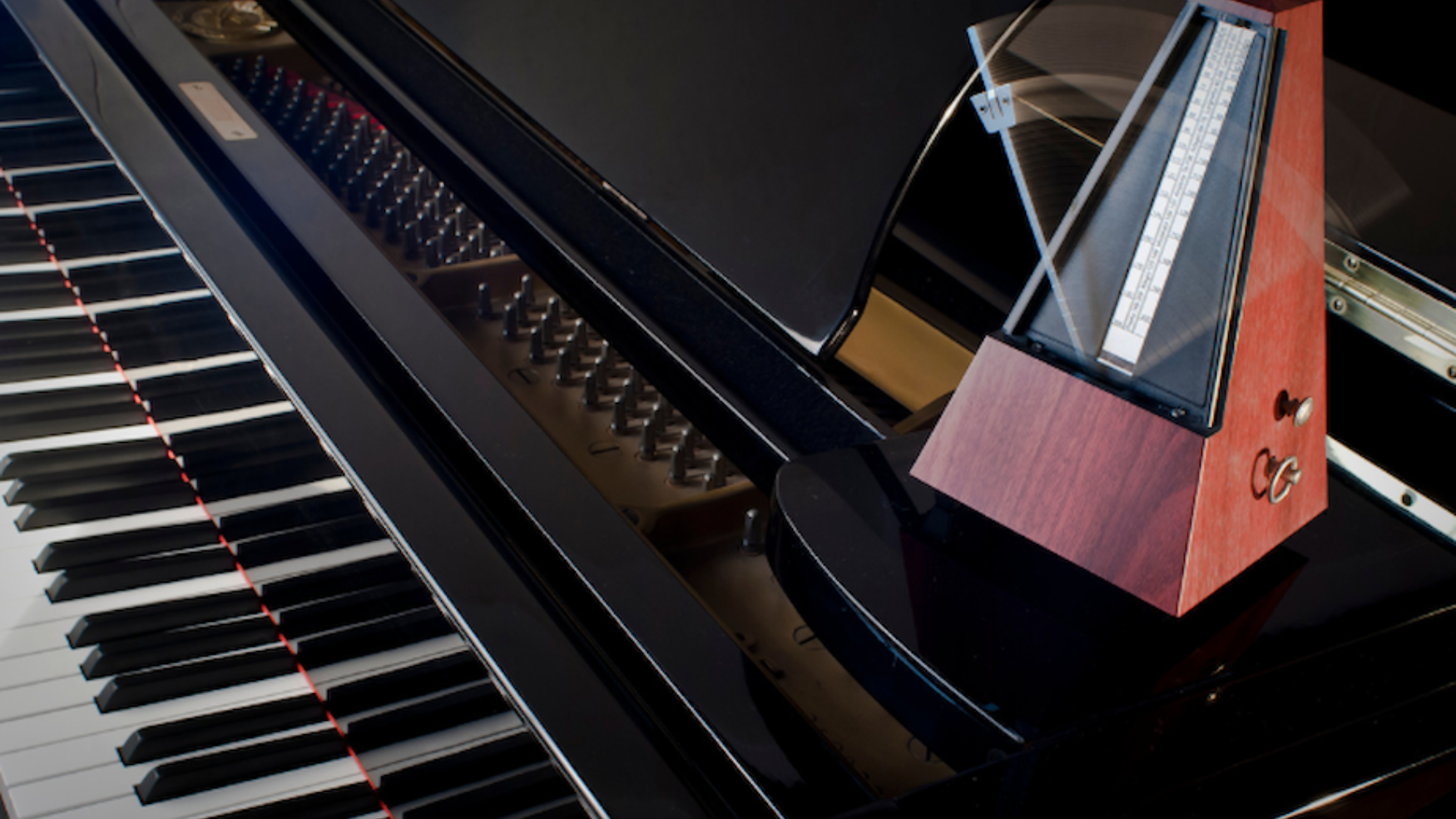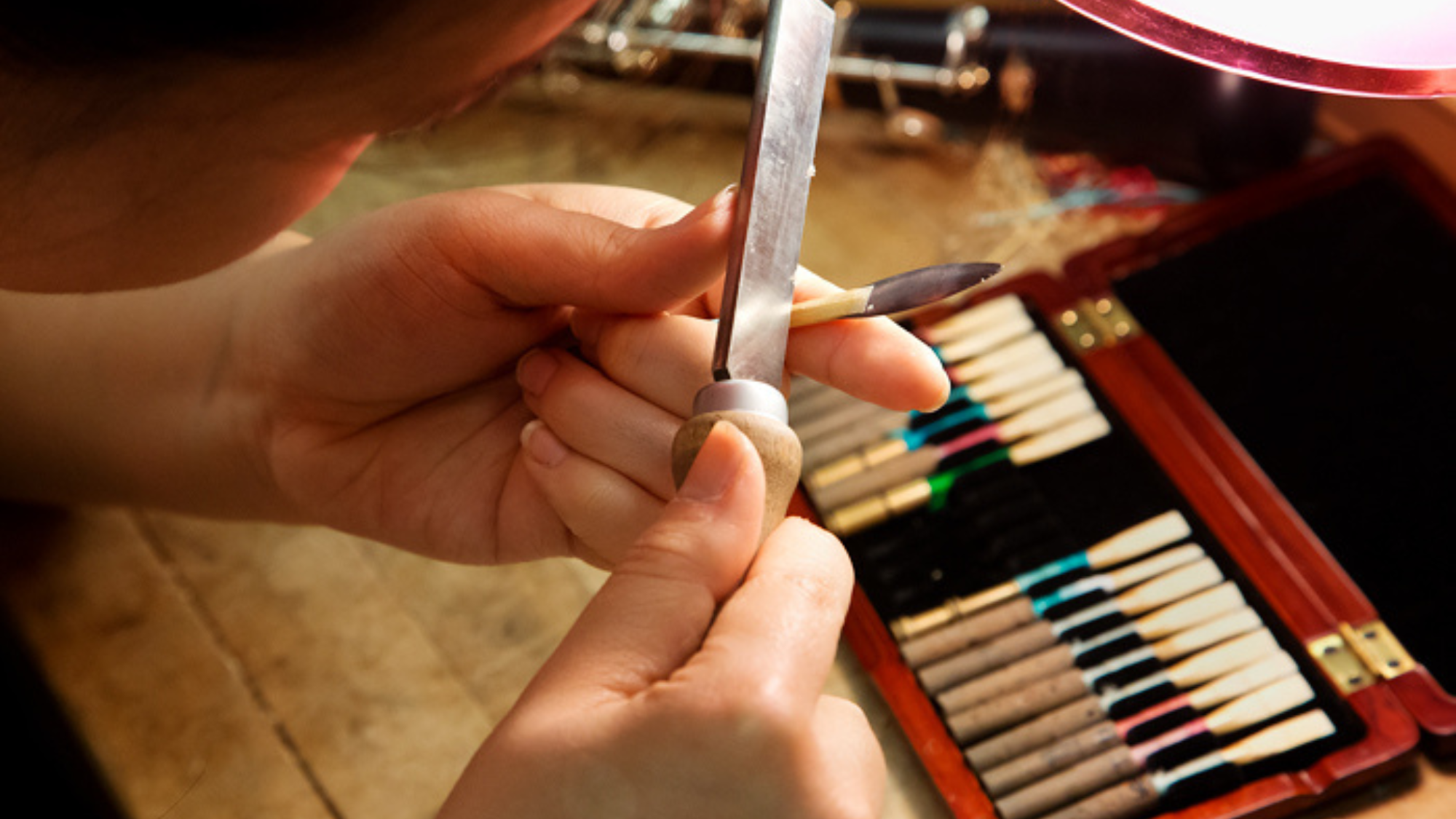Introduction
A properly functioning saxophone reed is essential for a successful performance. In addition, possessing several good reeds can boost confidence and motivate saxophonists to perform at their highest level. Likewise, not having an assortment of playable reeds can cause performers much anxiety, a loss of concentration and preoccupy their thoughts, preventing them from focusing on other important musical aspects of performance. To ensure that good reeds are always available for a performance, it is suggested that saxophonists become aware of and practice reed storage and longevity strategies that will assist them in producing a storehouse of playable reeds ready for use.
Reed Storage Strategies
After a practice session, rehearsal or performance is finished, the saxophonist should remove the reed from the mouthpiece and properly store it in a reed case. If the reed is left on the mouthpiece or not stored properly, it may be accidentally damaged or warp as it dries out causing response problems and also diminishing the life of the reed. A reed that is stored properly plays more consistently and gives saxophonists added confidence since they know the reed will remain stable throughout a concert.
Reed Cases
There are several types of reed cases available for storing reeds that vary in price and features offered. In order to properly store reeds, a reed case must contain a secure method of holding the reeds in place and a hard, flat surface that will keep the reeds from warping as they dry. Most reed cases are made from plastic, wood or metal, designed to hold from four to eight reeds, and contain a glass or plexiglass bed for the reeds to lie on.
An additional feature that some reed cases offer is a way to control humidity so reeds will not dry out completely or too fast. This is usually accomplished by some type of disposable humidity pack that is placed in the reed case alongside of the reeds. This pack usually lasts from one to two months before it has to be replaced.
If a reed case is purchased that does not contain a method for controlling humidity, one solution is to place the reed case into a Ziploc plastic bag along with a humidity pack. This will achieve the same result as if the pack was inside the case itself. Protec, Rico, Selmer and Vandoren currently manufacture reed cases that are used by many professional saxophonists and offer an excellent way to store reeds.
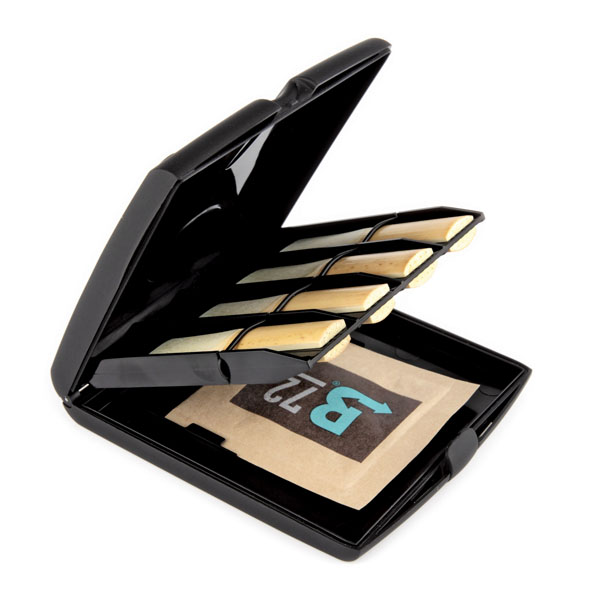
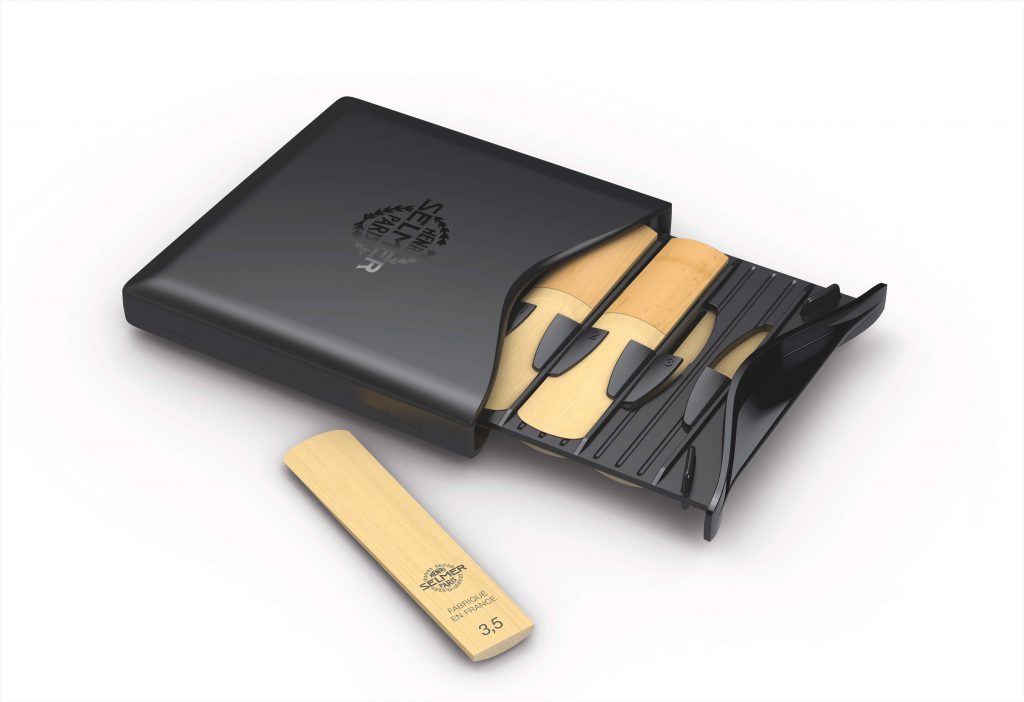
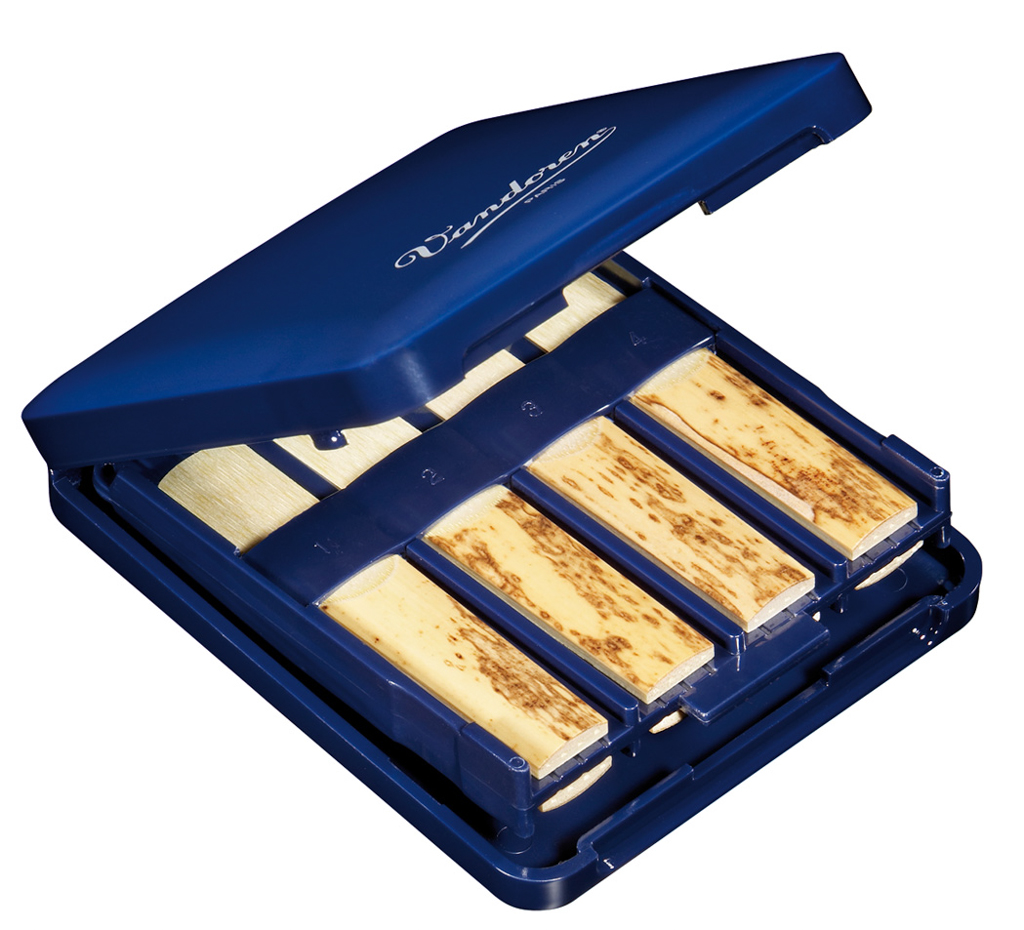
Making a Reed Case
Instead of buying a reed case, some saxophonists may prefer to make their own, which is also a viable option. To construct a reed case, a plastic airtight container with a removable lid is needed. Next a small sheet of plexiglass should be obtained and cut into plates that are the appropriate size to fit into the container. A hacksaw may be used to cut the plexiglass and large rubber bands will hold the reeds flat to the plexiglass plates by stretching across the body of the reed and around the plate.
To control humidity, a small moist sponge should be placed in the container with the reeds. To control the growth of mold, a small amount of mouthwash can be applied to the sponge since the alcohol contained in the mouthwash will kill any mold before it can accumulate.
Reed Longevity Strategies
It is important for saxophonists to practice reed longevity strategies and to properly care for their reeds. A well-cared-for reed will reward the performer by producing a good tone, excellent response, playing consistently, and having a long life. In addition to reed preparation and proper reed storage procedures, additional strategies for extending the life of a reed are rotating and reviving dead reeds.
Rotating Reeds
It is recommended that saxophonists rotate their reeds when practicing or performing instead of playing only on one reed until it is worn out and then replacing it a new one. Rotating reeds provides several advantages, one of which is increasing the life span of the reed. By rotating reeds, the cane fibers of the reed are allowed to recover after each playing which greatly extends the life of the reed.
Another advantage of rotating reeds is that the saxophonist will always have backup reeds in case the primary reed becomes unplayable. Sometimes a reed that is reserved for a performance may not play well on the day of the event. This may be due to a change in altitude, humidity level, temperature, concert hall conditions, the reed being damaged or simply wearing out. By rotating reeds, the saxophonist will always have a reed to play when the primary reed will not.
A third benefit from reed rotation is that there will be little or no embouchure adjustment needed when switching from one reed to the next. When saxophonists play one reed until it is worn out and then switch to a new one, there is a big difference between the two. The new reed may be much harder to blow requiring adjustments in the embouchure and breath support. These adjustments may feel very uncomfortable to saxophonists not only physically but also mentally, shifting their focus from the music being performed to concerns about the reed.
When rotating reeds, the exact number of reeds included in the rotation is a personal choice. Some saxophonists may rotate seven reeds, one for each day of the week while others prefer more or less. It is highly suggested that at least four reeds be included in the rotation, while other reeds are constantly being worked in to replace reeds that are worn.
In order to keep track of the reed rotation, a labeling system should be used where each reed receives a number reminding the saxophonist which reed is next in the rotation. For example, if the reeds are numbered 1 through 4 and the saxophonist is currently playing on reed number 3, the next reed in the rotation would be reed number 4, followed by reed number 1. The rotated reeds should also be properly stored in a humidity-controlled reed case when not in use.
In addition to the rotation number, saxophonists may also want to place an additional label on each reed when preparing for an upcoming performance. The additional label ranks the reeds based on their playability. If saxophonists are using numbers to label reeds for rotation purposes, a lettering system could be used to rank the reeds based on how well they play. The best reed could be labeled with the letter “A”, the second-best reed with a “B” and so on. This labeling system will be very helpful when selecting the best reeds to be used in an upcoming performance even though the rankings could change depending upon the performance venue and climate. Also, when preparing for an upcoming performance, some saxophonists may wish to remove performance reeds from their normal rotation order to save them for the concert. However, this is a personal decision and may vary depending on the performer.
Reviving Dead Reeds
Every saxophone reed made of cane will eventually wear out due to being damaged, the cane becoming too soft, or the tone and response of the reed deteriorating to such a poor level that the reed is unplayable. Reeds in this condition are referred to as being “dead” and are usually thrown away by most saxophonists. However, for saxophonists who are not ready to throw a dead reed away, there are several ways to revive it.
One way to prolong the life of a dead reed that is too soft is by clipping it with a reed trimmer. However, a clipped reed may feel, play, and sound different due to the shape of the clipped tip, which is never exactly the same as the original reed. Nonetheless, this is a viable option as long as the reed is not too adversely affected by this action and the saxophonist is aware that a reed can only be clipped so many times before it is useless.
Other reeds may be considered dead not because they are too soft, but due to the poor tone, they produce as a result of their cane fibers being damaged or clogged. Placing reeds in this condition in a bowl of warm water and gently scrubbing the cane, either with the fingers or a soft cloth while making sure not to break the fibers, is an excellent way to revive them. Another way to revive dead reeds in this condition is to place them in a bowl of hydrogen peroxide for several minutes. The hydrogen peroxide will bubble into the cane fibers removing any impurities that may be clogging them up. When the reeds are finished soaking, remove and rinse them with warm water before playing. These actions will unclog the cane allowing these reeds to vibrate more freely improving their resonance, response, and increasing their life span.
These suggestions for reed revival may be used separately or combined with each other depending on what works best for each performer. Because a dead reed is unplayable in its current condition, saxophonists are encouraged to try these methods since they really have nothing to lose. The worst thing that could happen is the dead reed could not be revived and is thrown away.
Summary
All saxophonists should be aware of reed storage and longevity strategies since they play an important role in performance. Properly storing, rotating and reviving reeds will definitely make a difference in how well saxophonists perform and also how confident they feel when performing. By utilizing these strategies, it is hoped that saxophonists will always have good reeds available allowing them to perform to their full potential.


